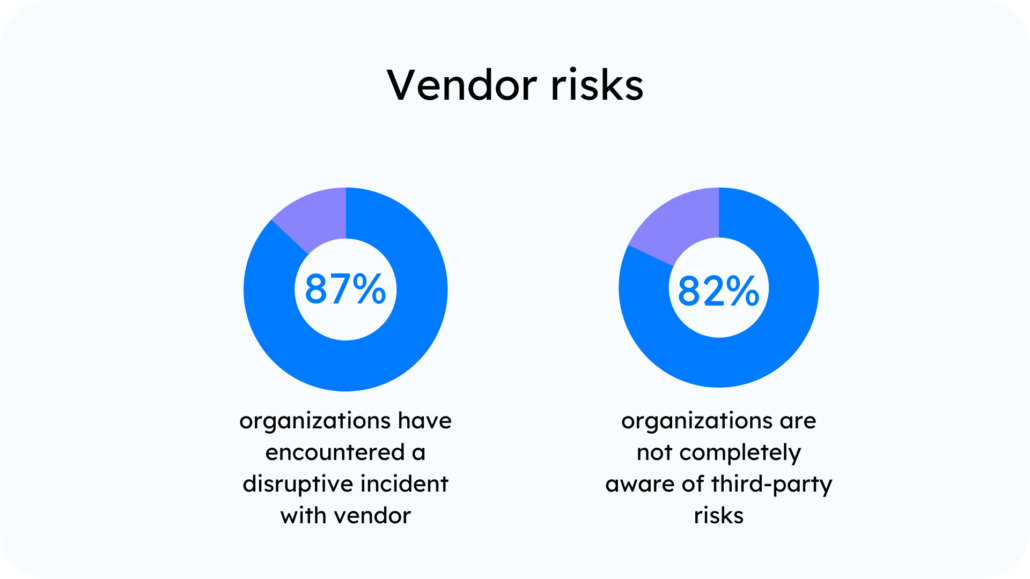What is vendor management?
Let’s understand this concept with a simple example.
Did you ever wonder why a flock of birds usually flies in the V-formation?
It is because V-formation increases their efficiency while traveling long distances. Every bird needs to fly in an orderly manner to ensure that the flock reaches its destination despite all the hurdles.
Similarly, your vendors must play their roles perfectly, to achieve your organization’s goal. Because, when you reach your goal, everyone benefits – the end-users, your vendors, and you.
To establish this level of coordination in your company, vendor management is essential.
What is vendor management?
Vendor management is the process of coordinating with vendors to ensure excellent service to your customers. It involves onboarding vendors, training them to use your platform, and engaging with vendors for improved profitability for both—your vendors and you. Vendor management also involves measures to control costs, mitigate risks, and improve vendor performance.
Nonetheless, managing vendors comes with its own set of challenges. Let’s look at them.
Challenges in vendor management
Your vendor management process generally depends on:
- Location (developed vs. developing nations)
- Market maturity (Are vendors aware of your platform or similar platforms?)
- The complexity of your process and tools you use to manage your vendors
To bring a broader perspective, we spoke to experts about the vendor management processes in the American and Indian markets.
Jim Goodrich, Co-founder of Continuous Process Improvement Systems, South Carolina Area, divulges the challenges that he faced in managing vendors. He says:
“In my experience, a big challenge was performance management. It may be considered as a part of overall contract management, satisfying terms, and conditions over time. Reasons for issues include that terms and conditions should change over time if managed actively.”
According to Jim,
“Not all suppliers should be managed the same. And this includes performance measures and performance review meetings.
Strategic, Leveraged and Critical Suppliers will have more extensive face time with higher execs and 2-way communications on possibly changing terms and conditions as market and other factors change—at least more so than those suppliers providing paper clips or office supplies.”
That’s a perspective from the developed world.
Managers in the developing nations like India face a different set of challenges. Covering inputs from Mr. Kumar Harshdeep, Former Vendor Manager at Flipkart.
“The major challenge with vendors in tier-two cities is educating them about the company’s selling platform. If the process is not explained properly, it increases the probability of mishandling orders. Eventually it affects their performance.”
During our conversation, Harshdeep shared an incident that further cements the need for proper vendor management.
“Once I ordered a product from a website that came with a note inside the packaging. It was from the seller. He requested to write a review on the online platform, and in return, he’ll credit Rs. 100 in the buyer’s digital wallet.”
Incidents like this usually go unnoticed. People order from big companies because they trust them. Any unethical activities such as this can mark a black spot on the organization’s reputation forever.
Hence, laying down guidelines on customer interaction, among other things during the vendor management process is essential. Let’s look at the process of managing vendors in detail.
What are the steps involved in vendor management?
Simply put, vendor management process is the set of directives to shortlist, onboard, and engage with vendors.
Essentially, the vendor management process involves 7 steps. Let’s look at each of these steps in detail.
1. Assess the vendor
Before onboarding any merchant, assess them for the quality of their product, time to supply, pricing, network, and reliability.
You’ll be surprised to know that 87% of organizations have encountered a disruptive incident with a vendor in last three years. In fact, 82% of companies aren’t sure if they’ve identified all third-party risks.

Many organizations use scorecards for examining their vendors. For example, out of 100, they allot 10 points for quality, 40 points for pricing, 20 points for supply time, etc.
The goal of analyzing your suppliers is to vet them for a long-term relationship. It’s important to identify if they can consistently deliver the promised output and quality.
2. Establish goals
To meet your sales goals, set up clear objectives for your vendors as well. More importantly, comprehend your business process in the utmost detail. It will help you structure and define clear performance metrics.
Convey your expectations and build a mutual understanding with your vendors. With strategic inputs, your vendors will be able to forecast your needs and maintain their inventory accordingly.
3. Negotiate a contract
To cultivate a relationship with your vendors, recognize and acknowledge their business objectives. For this, author a legitimate contract that is beneficial for both parties.
Negotiating too much for prices and restricting the profit margin of your vendor can hamper the quality of the product. To avoid that, plan the terms of the contract in such a way that they are mutually profitable.
4. Onboard the vendor
When your organization and the vendor land at mutually beneficial grounds, Sign the contract and onboard the vendor.
The onboarding process involves guiding the vendor into your company’s network. A good vendor onboarding process guarantees the commencement of a smooth relationship.
Learn more about building an optimal vendor onboarding process through this webinar:
However, if you’re new, vendors may not know about your platform. In this case, you’ll have to build a team to go door-to-door and educate vendors about your platform.
But there’s one more thing that fast-growing marketplaces do. They employ field employees and use vendor onboarding tools to educate + onboard vendors in one go. For example, leading marketplaces like Amazon Pay, Meesho, and Dunzo use LeadSquared’s mobile app for onboarding vendors on the go.

5. Monitor your vendor’s performance
After conveying your expectations, you expect your vendors to work as per the indicated standards of contract. But most of the time, the situation is far from ideal.
You need to constantly monitor your merchants and ensure that they are working at their highest potential.
The vendors who perform exceptionally well are called as strategic vendors. Take their perspective while establishing new vendor policies or changing the current ones.
6. Communicate regularly with your vendors
On average, U.S. retail operations have a supply chain accuracy of only 63%. This can result in significant delays and re-stocking issues. For example, 34% of businesses have shipped an order late due to selling a product that wasn’t in stock.
It is possible to avoid such instances through regular communications with vendors about their stock, supply-network, and more. Many organizations hold gatherings and forums to talk about vendor issues. Here, vendors are guided and are provided with tips to improve.
7. Reward your vendors
Vendors see themselves as a part of the organization when you reward them for their performance. Organizing reward campaigns motivates your vendors and establishes a healthy competition among them. Vendor performance is beneficial for your company in the long run.
The importance of vendor management
Your success depends on your vendors’ success. And there is only one way to build good relations with vendors. That’s through effective vendor management. It helps you:
- Catch up with the market trends: You can inform your vendors about an ascending demand in the market. Subsequently, you can also advise them to maintain their inventory to satiate the soaring need in the marketplace.
- Leverage the opportunity to improve: Strategic meetings helps your vendors improve consistently. It gives them an opportunity to learn from other vendors and improve. At the same time, you can also learn from your vendors. For instance, their challenges. And provide appropriate solutions or tweak your processes to suit their needs.
- Build long-term relationships: For a long-term association with vendors, it is essential to ensure that they are accomplishing their business goals. To that effect, vendor management assists them in realizing their goals by measuring their performance and providing inputs to increase their sales.
- Provide better quality of products: The ultimate goal of vendor management is to provide a standard quality of products and services in a stipulated time and minimal cost. A proper vendor management process helps you ensure that the product quality and customer expectations are always met.
The above points clearly show why vendor management is important for the growth of your organization. However, setting up a process is just one piece of the puzzle. Executing it properly is a completely different ball game. In the next section, we will discuss how technology can help you ramp up your process.
Features of a vendor management tool
Software tools make it easy to onboard and manage vendors. When I say vendor, I talk about the entire conglomeration of suppliers, merchants, driving partners, and sellers. But before we discuss the benefits of using tools, a quick look at the features of an ideal vendor management software.
Feature | Impact |
Activity log | You will need to understand how well your vendor interacts with your platform. Tracking activities will help you achieve that. |
Centralized data repository | Having a central repository for all vendor-related information, compliance documents, self-help documents, contracts, etc. make it easy to access and use the information as and when needed. |
Communication | Your software should support communication through more than one channel, allow bulk messaging, and easy information exchange. |
Onboarding | The onboarding module in your vendor-facing software should allow application, document collection, verification, and connect the verified vendor with your organization’s workflows. |
Payments | The software should either provide payment functionalities or integrate with payment gateways. |
Performance tracking | Tracking vendor’s every move is important to reduce risk and help them make more sales. |
Self-service portal | A vendor portal to upload documents, access transactions, and more. |
How does a vendor management tool help businesses?
Once you have implemented a vendor management tool, it will streamline your vendor management process in the following ways:
1. Capture inquiries and perform screening
A lot of times you’ll receive business inquiries from sellers. Here, two main functions come into play:
- Capture inquiry into your central system,
- And assign the request to your team for verification and onboarding
Now, a lot of inquiries you receive might not fit your vendor selection criteria. Sometimes, it could be the region they operate in, or sometimes it could be the scale they’re not able to meet. Manually vetting them could be time consuming.
Vendor onboarding software qualifies leads based on predetermined criteria. It ensures a high-quality funnel and prevents you team wasting time on non-serious merchants.
2. Automate your processes
Simple processes like application, document collection, etc. can be automated. For instance, you can provide self-serve portals to increase merchant self-listing. Again, you can automate tasks like document collection through vendor portals.
You can also use your merchant management software to map vendors to your team members for vendor verification, onboarding, and other operational tasks. Even if you are hosting an event, then the tool can easily help you manage the event ticketing and registration effortlessly.
Another use case of merchant management software is—automate engagement campaigns. As mentioned above, you need to communicate regularly and stay in touch with your vendors to keep them engaged. You can use software tools to ask for their feedback, send tips to increase sales, product and marketing updates, etc.
3. Equip you teams with smart tools
If your process requires field visits for your teams, tools like mobile CRM comes in handy. Your team can carry field visits with ease and update the vendor status through the app itself.
Some of the benefits of using mobile CRM for field teams are:
- Share automated day plans to your team based on the leads assigned to them
- Give meeting recommendations
- Track if your team are at the right location and interacting with the right vendors
- Collect documents and onboard vendors on the fly
4. Track the performance of your vendors
There are two main reasons why you should keep an eye on your vendor activities.
- Mitigate risks like vendors supplying faulty products, not delivering on time, etc.
- Identify top sellers, best-selling products, and more
Merchant management tools make it easy to track your vendors. You can utilize this information to motivate sellers who are trying hard to succeed on your platform. Data-driven insights through software will also help you make informed business decisions.
[Also read: Supplier Relationship Management (SRM): Strategy, KPIs, and Tools]
These are just some of the many benefits of using software to manage your vendor-related processes. And companies have realized success and fast growth with these tools. I would like to share the story of Meesho, India’s leading reseller marketplace, who improved its vendor onboarding efficiency by 70% through technology.
Success story: How Meesho increases supplier onboarding by 70%!
Meesho, an Indian-origin reseller marketplace, enables individual resellers to promote their products by posting on social media platforms like WhatsApp, Instagram, Facebook, and other social channels. Operating on a reseller base of over a crore, Meesho is spread over 5000+ cities and towns. In June 2019, it became India’s first-ever startup to secure funding from Facebook.
Meesho connects suppliers and resellers, where the suppliers take their inventory online and the resellers market those products to the end-user. With suppliers in such a key role, the company found it challenging to keep them committed. Also, as their team expanded, they needed a platform to onboard and manage their suppliers.
The solution:
Meesho, with LeadSquared’s vendor onboarding platform, found a solution to the chaos.
- They automated the onboarding process with auto lead distribution and timely alerts to salespeople.
- With workflow automation, operations and finance teams could easily access and verify vendor documents.
- The team is able to track the journey of the vendor with them.
“Where an individual salesperson took around 8-10 mins to fill in the required details of a prospective supplier, with LeadSquared it just takes a minute. We are very pleased to see that the productivity of the team has increased to 70% from an earlier 5-10%.”
Saurabh Sudhanshu Tripathi, Senior Business Development Manager-Inside Sales, Meesho
You can also automate your vendor management process. Book a quick demo and explore how LeadSquared can help.
FAQs
The challenges in vendor management include:
1. Managing vendor relationships
2. Personalizing and streamlining vendor onboarding
3. Tracking vendor performance
4. Ensuring that vendor compliances are being met
5. Vendor reputation risk
6. Managing contracts and other documentation
A vendor management system helps businesses by automatically capturing and qualifying leads. It also automates vendor management processes, like documentation, using a vendor portal. To improve the efficiency of your teams, you can use a mobile system to manage field force teams.
The vendor management process involves 7 steps:
1. Assess the vendor
2. Establish goals
3. Negotiate a contract
4. Onboard the vendor
5. Monitor their performance
6. Communicate regularly
7. Reward their performance









